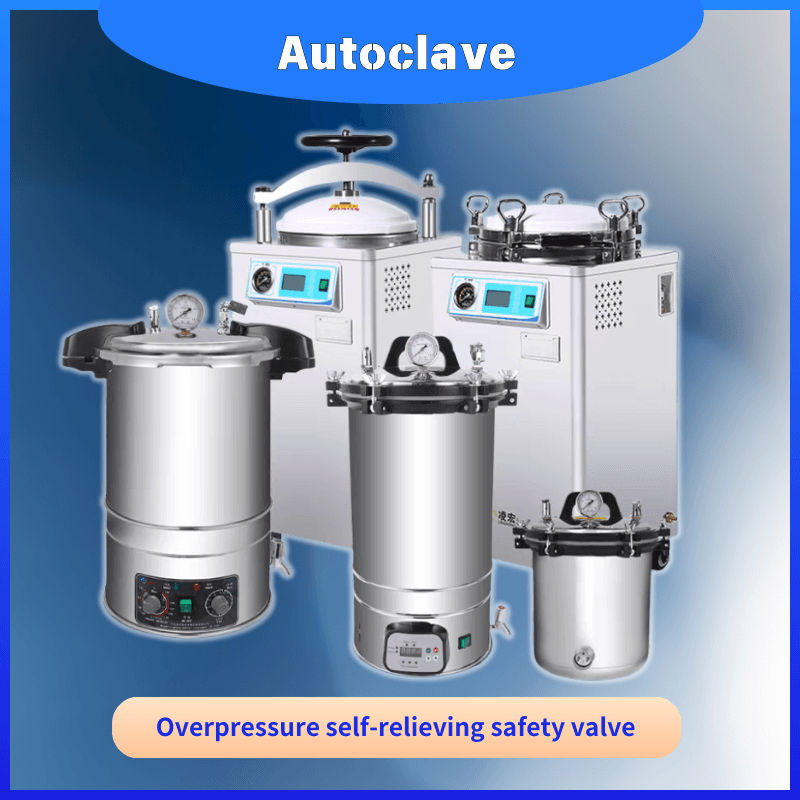
This article will cover the scientific principles of autoclave machines and detail their important components followed by a step-by-step operational guide. This step-by-step guide caters to beginners and advanced users who wish to understand autoclave machine operations.
Autoclave machines operate on steam sterilization principles where heat and pressure work together for a set duration to eliminate bacteria, viruses, fungi and spores.
Steam: The primary sterilizing agent. Water reaches its boiling point under pressure to generate saturated steam.
The application of pressure raises water’s boiling point which enables steam to achieve temperatures higher than 100°C.
The extreme heat causes proteins within microorganisms to break down which leads to their destruction.
For example:
Most microorganisms are eliminated within 15 to 30 minutes when exposed to steam at 121°C (250°F) and 15 psi.
The sterilization process reaches completion in 3–10 minutes when working at 134°C (273°F) and 30 psi.
The system eliminates heat-resistant spores which establishes autoclaves as a highly dependable sterilization technique.
Learning about autoclave operation requires understanding its essential components.
The primary compartment for sterilization holds the items that need to be processed.
The chamber is constructed from stainless steel to endure extreme pressure and temperature conditions.
Produces the high-pressure steam necessary for sterilization.
Certain autoclaves operate using steam from an external source rather than generating their own.
Regularly monitor and control internal parameters to achieve precise sterilization results.
Users can set sterilization parameters on the control panel by adjusting temperature settings along with pressure and cycle duration options.
Once sterilization finishes its cycle the exhaust valve opens to release steam and pressure.
The gasket maintains an airtight seal which keeps pressure contained within the chamber.
An autoclave machine operates through a series of steps.
Insert all items requiring sterilization into the autoclave chamber.
Arrange items with adequate space between them to facilitate unobstructed steam movement. Excessive items in the chamber block steam from reaching all surfaces and reduce the effectiveness of sterilization.
Close the door securely. The gasket creates a tight seal that stops steam from leaking out of the chamber.
The removal of air creates space for steam to enter and occupy the chamber.
Steam enters the chamber and pushes out air through an exhaust valve.
The Pre-Vacuum Method first employs a vacuum pump to extract air from the chamber before introducing steam for enhanced penetration into porous materials.
High-pressure steam is introduced into the chamber.
The temperature reaches the predetermined sterilization threshold (such as 121°C or 134°C).
The autoclave holds these sterilization conditions for the necessary time frame of 15–30 minutes.
After finishing sterilization the machine opens the exhaust valve to release both pressure and steam.
The chamber temperature lowers while items undergo drying to stop recontamination.
After cooling, sterilized items are carefully removed.
Items must be handled correctly to preserve their sterile condition until they reach their point of use.
Autoclave effectiveness depends on two essential factors.
To effectively eliminate microorganisms sterilization requires temperatures between 121°C and 134°C.
Increased temperatures result in reduced sterilization cycle durations.
The pressure range of 15–30 psi raises the boiling point of water and enables steam to achieve temperatures essential for sterilization.
The process enables steam to permeate through porous materials and complex instruments.
Autoclaves operate dependably but sometimes experience unexpected problems. Here’s how to address them:
Cause: Damaged gaskets or improper sealing.
ソリューション: Inspect and replace gaskets regularly. Ensure the door is closed properly.
The sterilization process fails because of chamber overloading or wrong cycle configurations.
ソリューション: Arrange items to allow steam circulation. Double-check temperature and pressure settings.
Cause: Faulty sensors or calibration issues.
Perform regular machine calibration and install new sensors when necessary.
Cause: Inadequate drying phase or excessive moisture.
The drying time should be prolonged or the drainage system for condensed water needs to be optimized.
Autoclave machines function as powerful sterilization instruments that use steam along with pressure and heat to reach high levels of effectiveness. You can achieve both safe and efficient sterilization processes by learning how autoclaves function and implementing proper procedures.
To achieve dependable sterilization results across medical, laboratory, or industrial applications you must operate and maintain the autoclave correctly.
Q1: What temperature is used in an autoclave machine? Autoclaves typically operate at temperatures between 121°C (250°F) そして 134°C (273°F), depending on the sterilization requirements.
Q2: How long does a sterilization cycle take? The duration varies but generally ranges from 15 to 60 minutes, depending on the load and type of autoclave.
Q3: Can all materials be sterilized in an autoclave? No, only materials that can withstand high temperatures and pressure should be sterilized in an autoclave. Heat-sensitive plastics and electronics are unsuitable.
For more information or assistance, contact ケリング・メディカル:
電子メール: inquiry@shkeling.com
WhatsApp: +8618221822482
ウェブサイト: https://autoclaveequipment.com/

The healthcare industry requires strict adherence to sterile conditions to protect patients from infections and maintain safety standards alongside regulatory compliance. Medical equipment dealers, distributors, and procurement specialists must understand

A fundamental aspect of infection control in health care systems revolves around sterilization to eliminate dangerous microorganisms from medical instruments and materials which both safeguards patients and adheres to strict

Medical facilities must prioritize sterility to prevent infections and protect patients while following strict regulatory guidelines. Medical equipment dealers, distributors, and procurement specialists who understand the function of autoclaves can

In medical settings sterilization remains a critical procedure which removes dangerous microorganisms from instruments and supplies to protect patients and maintain strict safety protocols. Medical equipment dealers, distributors and procurement

Healthcare infection control depends on sterilization to make medical instruments and materials safe from harmful microorganisms while upholding patient safety and strict regulatory standards. Medical equipment dealers, distributors and procurement

The sterilization process plays an essential role in healthcare by eliminating harmful microorganisms from medical instruments which ensures patient safety and meets strict regulatory requirements. Medical equipment dealers, distributors and